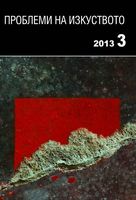Материали в украсата на ръкопис Cod. D. Gr. 212 от ЦсвП „Проф. Иван Дуйчев”
Materials for the Illumination of Manuscript Cod. D. Gr. 212 from the Ivan Duichev Center for Slavo-Byzantine Studies
Author(s): Nikifor HaralampievSubject(s): Fine Arts / Performing Arts
Published by: Институт за изследване на изкуствата, Българска академия на науките
Summary/Abstract: The Lectionary Cod. D. gr. 212 was completed in 1378 at the Hodegon monastery in Constantinople and is richly decorated with illuminated headpieces and initials. In the XIX century the co- dex was rebound and 12 full-page miniatures, dating from the XI–XII century, were added to the book block. The present contribution discusses the results from the scientific analysis of the parchment, the gilding, the pigments and the binding media used for the decoration from the two periods. The methods employed for the identification of the mate- rials include visual analysis, SEM-EDS, micro-Raman spectroscopy, FTIR, ELI- SA and HPLC. The parchment from the two periods is made of goat skins. The XIV century folios are coated with ground, consist- ing of white lead in egg binder. Similar ground was found also in other manu- scripts, originating from the Hodegon monastery. The parchment for the earlier miniatures is covered just with a thin layer of calcium carbonate. The pigments identified in the XIV century decoration include: white lead, orpi- ment, yellow ochre, vermilion, red lead, indigo and lazurite of different purity. Surprising results were obtained from a sample from f. 242r, where the material, used to paint the darker areas over the vermilion in the headpiece, was found to be iron gall ink. The binder used in the most of the headpieces is plant gum, but on the folios 121v and 306r the paint media is egg. The gilding in all of the examined headpieces was made with 24-carat leaf gold, except for the head- piece on f. 306 where the gold leaf con- tains about 6 % silver. The pigments identified in the XI–XII century miniatures are: white lead, lead-tin yellow type II, pararealgar with little amount of orpiment, yellow and red ochre, vermilion, red lead, lac dye lake, lazurite, indigo, carbon (possibly bone) black and iron containing black pigment. The binder in all success- fully analyzed samples was found to be egg. Egg was used also as an adhesive for the gilding. Both gold leaf and powdered gold, containing 3-4 weight percent silver, was used in different areas of the miniatures. The low silver content led to a reddish purple discoloration of the gilding, where it was in contact with the sulfide ions from the pararealgar pigment (As4S4). The reason for the color shift is most probably the formation of different red silver-gold sulfides such as AuAgS. The thickness of the gold leaf from the two periods is very similar and is between 125 nm and 150 nm.
Journal: Проблеми на изкуството
- Issue Year: 2013
- Issue No: 3
- Page Range: 17-25
- Page Count: 9
- Language: Bulgarian
- Content File-PDF

